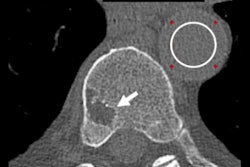
Tuesday, December 3 | 3:00 p.m.-3:10 p.m. | SSJ22-01 | Room N226
Photon-counting CT can match the image quality of conventional sinus and temporal bone CT at approximately one-sixth the radiation dose, according to researchers from the Mayo Clinic in Rochester, MN.They investigated the extent to which a whole-body photon-counting CT scanner at their institution could reduce radiation dose without noticeably altering the image quality of head CT scans. For the scans, they used a tube potential of 100 kV with a 0.4-mm tin filter and an ultrahigh-resolution acquisition mode featuring 0.25-mm detector pixels.
"The ultrahigh-resolution capability of the photon-counting detectors enables the use of 'dedicated sharp' kernels to improve visualization of submillimeter anatomical structures such as the nasomaxillary sutures of the midface and stapes in the middle ear," Kishore Rajendran, PhD, told AuntMinnie.com.
To test the technology, the researchers first acquired photon-counting CT scans of the sinuses and temporal bone of a head phantom. They found that photon-counting CT was able to achieve the same image noise as conventional CT at roughly one-sixth of the radiation dose for the temporal bone and with a 72% reduction for the sinus. For the temporal bone, the conventional CT scans used about 60 mGy and the photon-counting CT scans about 10 mGy; the radiation dose was 15 mGy with conventional CT and 6 mGy for photon-counting CT for the sinus.
Upon applying the technology to patients in a clinical setting, Rajendran and colleagues discovered that photon-counting CT reduced radiation dose nearly the same amount for patients as it did for the phantom.
"The demonstrated reduction in radiation dose from photon-counting CT could benefit both adult and pediatric populations where repeat CT scans are often prescribed for diagnosing and monitoring cystic fibrosis, ciliary disorder, chronic sinusitis, recurrent cholesteatoma, and conductive hearing loss," Rajendran said.
This paper received a Roadie 2019 award for the most popular abstract by page views in this Road to RSNA section.




















